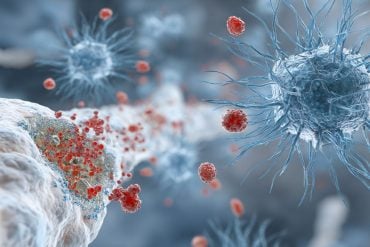Summary: Layer 5 pyramidal neurons, crucial for brain information processing, vary significantly in their synaptic protein composition based on neuron type. Research shows that intratelencephalic (IT) neurons and pyramidal tract (PT) neurons share some synaptic proteins but also have unique characteristics influencing their functions.
These distinctions may explain their varying vulnerabilities to autism and schizophrenia. Future studies aim to explore how autism-related genes affect IT neurons’ wiring and information processing.
Key Facts:
- Neuron-Specific Synapses: IT and PT neurons have unique synaptic protein compositions that influence their roles and disease susceptibilities.
- Autism Vulnerability: IT neurons’ synapses appear more susceptible to autism-related genetic disruptions.
- Mapping Technique: Proteomics was used to profile synapses, revealing insights into neuron-specific roles in brain circuits.
Source: VIB
Specific brain cells known as layer 5 pyramidal neurons play a vital role in how our brains process information.
Research by the team of Prof. Joris de Wit (VIB-KU Leuven) and colleagues highlights the differences between two types of these brain cells —intratelencephalic (IT) neurons and pyramidal tract (PT) neurons—and how these differences may affect their vulnerability to conditions like autism and schizophrenia.

Profiling synapses
Among the neural circuits that let our brain process information, brain cells known as layer 5 pyramidal neurons integrate information from various sources and then distribute it to where it needs to go, like relay hubs in our brain.
To understand how these brain cells exchange information through their synapses (junctions to exchange chemical ‘messages’), the team of Prof. Joris de Wit (VIB-KU Leuven Center for Brain and Disease Research) used a sensitive technique called proteomics to profile the synapses of two types of mouse layer 5 neurons —intratelencephalic (IT) neurons and pyramidal tract (PT) neurons, each with different functions in relaying information.
Working with proteomics expert Prof. Andy Howden (University of Dundee, UK), they discovered that while both types of neurons share some synaptic proteins, they also have unique features that may influence their functions and their susceptibility to certain autistic traits and mental health disorders such as schizophrenia.
Disease vulnerability
“Mapping the synaptic protein composition of layer 5 neurons is an important step in understanding how these neurons are wired into neural circuits and how this process may be affected by neurodevelopmental disorders,” says Prof. Joris de Wit.
“Our findings suggest that the synapses of layer 5 IT neurons are more susceptible to autism.”
In follow up studies, supported by the Simons Foundation, the team of Prof. Joris de Wit will investigate whether autism risk genes affect wiring and information processing of layer 5 IT neurons.
Dr. Gabriele Marcassa, first author of the study, adds, “By extending our approach to mapping synaptic profiles of different neuron types in the brain, we can begin to understand their roles in health and disease.”
Funding
This research was supported by FWO – Research Foundation Flanders.
About this neurodevelopment research news
Author: India Jane Wise
Source: VIB
Contact: India Jane Wise – VIB
Image: The image is credited to Neuroscience News
Original Research: Open access.
“Synaptic Signatures and Disease Vulnerabilities of Layer 5 Pyramidal Neurons” by Joris de Wit et al. Nature Communications
Abstract
Synaptic Signatures and Disease Vulnerabilities of Layer 5 Pyramidal Neurons
Cortical layer 5 (L5) intratelencephalic (IT) and pyramidal tract (PT) neurons are embedded in distinct information processing pathways.
Their morphology, connectivity, electrophysiological properties, and role in behavior have been extensively analyzed. However, the molecular composition of their synapses remains largely uncharacterized.
Here, we dissect the protein composition of the excitatory postsynaptic compartment of mouse L5 neurons in intact somatosensory circuits, using an optimized proximity biotinylation workflow with high spatial accuracy.
We find distinct synaptic signatures of L5 IT and PT neurons that are defined by proteins regulating synaptic organization and transmission, including cell-surface proteins (CSPs), neurotransmitter receptors and ion channels.
In addition, we find a differential vulnerability to disease, with a marked enrichment of autism risk genes in the synaptic signature of L5 IT neurons compared to PT neurons.
These results align with human studies and suggest that the excitatory postsynaptic compartment of L5 IT neurons is susceptible in autism.
Our approach is versatile and can be broadly applied to other neuron types to create a protein-based, synaptic atlas of cortical circuits.






